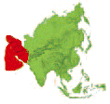DK People & Places: Western Asia & the Middle East
The Middle East is the name given to the area of land between the Red Sea and the Gulf, from Israel in the west to Iran in the east. Along with western Asia, much of this land is inhospitable, with dry desert in the Arabian Peninsula, and mountains in Iran and Iraq. Turkey is dominated by a high plateau, but has plenty of fertile farmland. There are snow-capped mountains in north Lebanon and Israel, which drop down to fertile plains along the coasts.
The discovery of oil in the Gulf has brought enormous wealth to Saudi Arabia, Iraq, Kuwait, and other desert countries, which now supply 30 percent of the world’s oil. Fleets of oil transporters have made the Gulf one of the world’s busiest seaways. The presence of oil has increased this area’s international importance and its influence on world affairs.
There have been many recent conflicts in the Middle East. In 1975, Lebanon suffered a violent civil war between the Christian and Muslim populations. In 1990 and 2003, international forces led by the US invaded Iraq, eventually deposing President Saddam Hussein’s regime. Today, huge tensions exist between Israelis and Palestinians, who lost their homes in 1948 when Israel was created as a homeland for the Jews.
Istanbul is the only city in the world to lie on two continents. Split by a narrow channel of water called the Bosporus Strait, the European and Asian parts of the city are linked by a number of bridges. Istanbul is Turkey’s largest city and home to nearly 9.4 million people. Once known by the name of Constantinople, Istanbul was Turkey’s capital from AD 330–1923.
At 1,312 ft (400 m) below sea level, the Dead Sea is the lowest place on Earth. This vast lake, 46 miles (74 km) long, lies on the border between Israel and Jordan. Its water is so salty that nothing can live in it, which is how the lake got its name. However, the mud on its shore is rich in minerals, and is said to have healing properties.
The Kurds are a stateless people, whose mountainous homeland of Kurdistan straddles the borders of Turkey, Syria, Iraq, and Iran. For many years, the Kurds have wanted self-government and tried to form an independent Kurdistan, but their attempts have been suppressed with violence and bloodshed. Many Kurds now live as refugees.
Many desert countries have no reliable source of fresh water and have to process sea water in desalination plants for domestic and agricultural use. Water is carefully managed throughout the region. Saudi Arabia’s huge irrigation program waters the wheat, fruit, and vegetable crops that are grown in the desert.
Over 95 percent of Saudi Arabia is dry, inhospitable desert, where daytime temperatures reach 48°C (118°F) and plunge to near freezing at night. The extreme temperatures and wind-borne sand wear down the desert rocks. The southern desert covers 650,000 sq km (250,000 sq miles) and is the largest expanse of sand in the world.
Capital city: Jerusalem (not internationally recognized)
Population: 6.6 million
Official languages: Hebrew and Arabic
Capital city: Riyadh; Jedda (administrative)
Population: 21.7 million
Official language: Arabic

